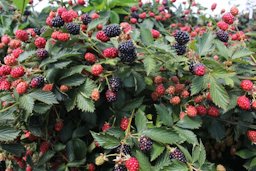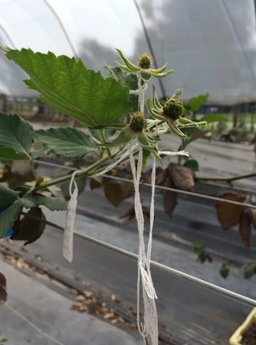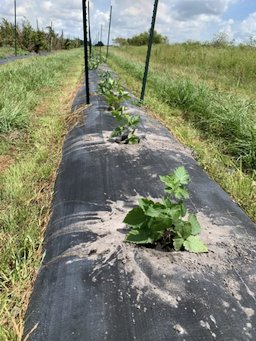Article from Specialty Crop Grower
by Zhanao Deng
Trialing and Developing Blackberries for Florida

Blackberries are grown as a commercial crop in North Carolina
Blackberry
has emerged as an alternative crop in Florida. More and more Florida
growers are growing or trialing blackberries for commercial production.
They have indicated a dire need for suitable blackberry cultivars that
can yield well and produce berries of good quality.
Past Cultivars and Research
In
the 1950s, University of Florida (UF) released two blackberry
cultivars, Flordagrand and Oklawaha. Both produced high yields of
large, attractive berries, but their trailing growth habit and thorny
canes made them unsuitable for commercial production.
The
University of Arkansas has maintained an active blackberry breeding
program for more than five decades and has released dozens of new
cultivars. Essentially all the blackberry cultivars currently grown in
Florida and other Southeast states are from this breeding program.
Some
of the popular floricane-fruiting cultivars include Apache, Navaho,
Natchez, Osage and Ouachita. They produce berries on second-year canes
(floricanes). In 2005, the program released the first
primocane-fruiting cultivars that can produce berries on the
current-year canes (primocanes) as well as floricanes. Prime-Ark® 45,
Prime-Ark® Freedom and Prime-Ark® Traveler have this new type of
fruiting habit.
With funding from the Florida Department of
Agriculture and Consumer Services Specialty Crop Block Grant program,
UF researchers began trialing these cultivars in 2017 in a blackberry
orchard at the Gulf Coast Research and Education Center (GCREC). Prior
to this, Shinsuke Agehara trialed Navaho, Natchez and Ouachita in
wooden boxes and large containers. In his trials, Natchez outperformed
Ouachita and Navaho. In the orchard trial, Osage had the highest yield
among the five floricane-fruiting cultivars, with an average of 3.9
pounds of berries per plant. Among the three primocane-fruiting
cultivars, Prime-Ark® Freedom had the highest yield, producing an
average of 6.3 pounds of berries per plant.
Researchers used
in-row spacing of 3 feet and between-row spacing of 10 feet in the
trials. With this spacing, 1,452 plants could be grown per acre. The
estimated per-acre yield would be 5,663 pounds for Osage and 9,148
pounds for PrimeArk® Freedom. Natchez showed significant variability in
berry yield from year to year or site to site.

Flowers are pollinated for blackberry breeding.
Current Cultivars
In
recent years, the University of Arkansas blackberry breeding program
has released two new floricane-fruiting cultivars, Caddo and Ponca.
Based on release documents, both cultivars are high yielding,
thornless, erect and produce medium to large fruit. Ponca is the
sweetest cultivar released to date and has good shipping and handling
traits. Both cultivars have been introduced to Florida, and a new trial
is being set at GCREC to test their performance. Stay tuned for trial
data in the next two years.
In small trials conducted in
Arkansas, these cultivars had the potential to produce 10,000 to more
than 20,000 pounds of berries an acre. Why do these cultivars yield
much less in Florida? Researchers think the primary reason is that
chilling requirements were not met in Florida, especially in Central
Florida. Very much like blueberries, blackberries need a period of
chilling (temperature below 45° F) to break sufficient numbers of buds
and develop enough flowers so that growers can have a decent crop.
The
current blackberry cultivars grown in Florida were bred and initially
selected in Arkansas, and they need 300 to 900 hours of chilling. On
average, Central Florida only has about 100 to 300 hours of chilling.
Without enough chilling, blackberry plants break much fewer buds, have
much fewer fruiting laterals and flowers, and yield poorly with berries
ripening over an extended period.
Building a Breeding Program
UF
trials and growers’ experiences indicate a strong need for new
blackberry cultivars that are better adapted to a low-chill
environment. This need prompted UF researchers to breed blackberries.
The breeding program received private funding and technical support
from Coastal Varieties Management. The GCREC and the UF Institute of
Food and Agricultural Sciences (IFAS) Dean for Research Office provided
funding to cover expenses associated with facilities.
In spring
2015, UF researchers made the first batch of crosses to produce
blackberry seeds. Newly produced seeds were treated with a strong acid
to burn part of the seed coat and then they were kept cold for several
months before they were germinated. The seedlings were then grown and
selected in Florida. Researchers repeated this process each year since
then.
So far, more than 10,000 blackberry seedlings or young
plants have been screened in Florida. Dozens of plants were selected
for further trials. Shoot tips have been collected from some of the
most promising plants and cultured in test tubes for rapid propagation.
The first batch of tissue culture-propagated blackberry young plants
from one of the selected lines was sent to growers this past June for
trialing.

Blackberry cultivar trials are underway at the Gulf Coast
Research and Education Center in Wimauma, Florida.
In
the meantime, researchers have set up the first replicated trials to
test the new line’s berry yield and quality. Effort is being made to
expand the blackberry orchard and produce additional liners for more
field trials, which is warranted to select the best adapted cultivars
for Florida growers.
As more Florida growers begin growing
blackberries, they have more questions needing practical solutions. To
better address growers’ needs, a UF/IFAS research and Extension team
has been formed. It consists of six specialists from the GCREC and the
Horticultural Sciences Department and two Extension faculty from
Orange, Marion and Hillsborough counties. Team members are well
experienced with berry breeding; variety selection and trials; plant
management and manipulation; fertilization; disease, insect pest,
nematode and weed identification and control, etc. The team has
received great support from Florida growers and some seed funding from
the UF/IFAS Support for Emerging Enterprise Development Integration
Teams program and the GCREC.
UF plans to produce the first
blackberry production and spray guide by early 2022 and provide growers
and Extension agents with more training. The goal of the team and these
efforts is to facilitate the development of the Florida blackberry
industry and help growers produce profitable crops sustainably.
|
|


